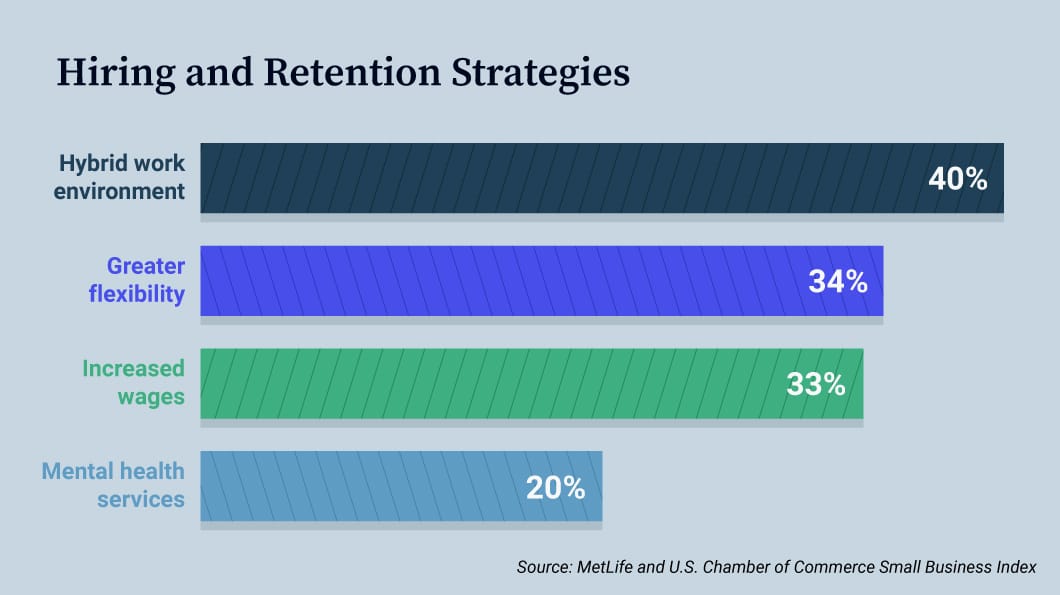Growing inflation and a looming recession aren’t the only factors affecting small business owners this year. Indeed, a tough labor market is also making it difficult for many to operate at capacity.
Not surprisingly, more than half of those surveyed for the recent MetLife and U.S. Chamber of Commerce Small Business Index indicated concern over filling job vacancies and keeping workers. Additionally, according to a June 2022 report by NFIB (National Federation of Independent Business), 94% of hiring businesses find it difficult to recruit qualified candidates.
That said, how can you hire much-needed talent and ensure they stay on? Some of the most common strategies noted in the Small Business Index include offering:
- Hybrid work environment (40%)
- Greater flexibility (34%)
- Increased wages (33%)
- Mental health services (20%)
However, many job seekers expect such benefits from would-be employers. So we decided to dig a bit deeper and ask entrepreneurs what they were doing differently to entice workers during this erratic time.
10 Competitive Strategies to Build Your Workforce
Here are several creative ways small business owners attract workers to their companies.
1. Be Upfront About Salary
In a labor market overrun by employment ads, one way many job seekers quickly filter which jobs to apply for first are the ones that list salary ranges upfront. After all, the time it takes to apply for just one job can easily take up a half-hour.
New York City actually passed a law requiring employers with 4 or more employees to post minimum and maximum salaries, effective in May 2022. While your city may not require this detail just yet, many job seekers on the hunt simply bypass those ads that don’t list salary ranges.
In this regard, Nick Mueller, director of operations of HawaiianIslands.com, shares: “The best way I’ve found to stand out in today’s employee-driven hiring market is to be upfront about job requirements and benefits. Employees don’t have patience for games anymore: They expect to know the salary range and the best and the worst the job has to offer by the time they sit down for an interview.”
2. Offer Unique Benefits
In addition to today’s commonly offered benefits of healthcare, 401(k) with matching, hybrid work schedules and generous paid time off, how can you set your company apart in the eyes of job seekers?
CEO and founder of Austin-based marketing and advertising agency Idea Peddler, Cimin Ahmadi-Cohen, says her company offers perks like Taco Tuesday, a fully stocked kitchen and 12 weeks of paid child leave. There’s also a coffee shop and restaurants within the office complex. Perhaps the most rewarding benefit, however, is a new homeowner grant, which Ahmadi-Cohen instituted to help employees establish roots locally.
In 2022 alone, Idea Peddler has grown its staff by more than 30% and was named one of the Best Places to Work by the Austin Business Journal.
3. Ask Current Staff to Post Job Openings
Word-of-mouth referrals don’t just work in the marketing world, they’re a trusted source for many job seekers too. With that in mind, ask your employees to post company job openings on their individual social media accounts. Consider that your workers may have even more followers than your company accounts and, consequently, greater opportunities to promote your job vacancy with more potential candidates.
Cody Candee, founder and CEO of Bounce, shares that more than half of his company’s workers have multiple social media accounts, which “provided us a great opportunity to extend our reach into the candidate market.”
“By asking our employees to post our job openings, industry-related articles about opportunities within our marketspace as well as their own job photos, we have been able to effectively reach into their networks and increase our candidate pool. In addition, it comes with the extra benefit of having the candidates already vetted by a trusted source.”
4. Offer Employee Referral Incentives
In a similar vein, consider making referrals financially worthwhile for your employees. “By incentivizing your current employees to find quality candidates, employee referral programs are an easy, cost-effective solution to the current labor shortage,” notes Loredo Rucchin, CEO of Jukebox. “Using good employee referral programs is one of the best ways to deal with the challenges of the current job market,” Rucchin goes on to say.
5. Show You’re Socially Responsible
Corporate social responsibility (CSR) is a crucial component of many of today’s best brands. Case in point, nearly 70% of workers wouldn’t work for a business that was lacking a strong purpose. (Perhaps even more important, 90% of employees say they’re more loyal, motivated and inspired when their employer has a strong sense of purpose.)
As Maria Shriver, co-founder and CEO of mission-driven company MOSH, notes: “Building your CSR initiatives into your brand story attracts candidates seeking meaningful employment. More and more employees are leaving their current situations to go work for companies that effect positive change in society and the environment. And a robust campaign highlighting your business’s good deeds invites them on your brand’s journey to do good in the world by telling the story of your initiatives.”
Shriver suggests demonstrating the progression of your company’s CSR efforts through videos, photos and posts. “Doing so will enhance your brand to consumers while attracting social-minded talent.”
6. Seek Military Veteran Candidates
Paul A. Dillon of Dillon Consulting Services LLC and adjunct instructor of veteran’s issues at Duke University suggests companies look to veterans for leadership and management positions within their organizations. He notes, “veterans want meaningful work to do” and advises businesses to hire veterans because of the valuable skills they can bring to a company, hopefully resulting in increased profitability.
“Reach out to Veteran Service Organizations and military nonprofit groups to assist your company with your veteran leadership hiring program,” suggests Dillon. “Most importantly, build military cultural competency into your company so that you understand the basics of the military and how military skills can add value to your products or services” (e.g., Psych/Armor).
“Also make certain that your Employee Assistance Program (EAP), if your company has one, includes any assistance that veteran leaders might need,” says Dillon.
Additionally, “create veteran affinity groups at your company, comprised not only of veterans, but also any of your employees who are currently military reservists, spouses of veterans and other employees who are simply interested in veteran issues. These affinity groups can serve as a valuable community for veterans, and those interested in them, to exchange views on what works or doesn’t work regarding veterans employed at your company.”
7. Prioritize Diversity, Equality and Inclusion
Workplace diversity is a key factor considered by 76% of workers when they’re weighing job offers, according to Glassdoor.
“The workplace is becoming a more stressful place and tensions are running high, but business owners have the opportunity to make life easier for their employees by fostering a respectful and dignified work environment,” shares Trey Ferro, CEO of Spot Pet Insurance.
“Prioritizing diversity, equality and inclusion in the workplace and recognizing successes on a regular basis are ways in which to boost employee morale and build a strong business reputation amongst the workforce.”
8. Partner With Colleges
“One of my favorite sayings is ‘If you want the freshest apple, you don’t go to the barrel, you go to the tree,’” says Matt Miller, CEO of Embroker. “We applied that philosophy by actively recruiting college students for positions in this challenging job market.”
“By setting up networks to offer opportunities to soon-to-be graduates, going to job fairs on college campuses, making connections with university employment offices and offering perks that would be attractive to students, we have effectively been expanding our recruitment efforts.”
9. Consider Alternative Recruiting Channels
Many hiring companies look to LinkedIn and Glassdoor for candidates, but there are other online avenues you could pursue. Have you ever thought about Slack?
Andrei Kurtuy, co-founder and chief commercial officer at Novorésumé, says “There are some recruiting channels on Slack that allow you to source job seekers since they are quite active on it.”
Kurtuy suggests joining at least 3 Slack channels to get in touch with potential candidates.
“My team has used Slack to hire some candidates and it proved to be extremely beneficial to them. It allows you to directly communicate with the candidates on the same platform.”
10. Promote the Position as a Side Job
In an industry that is often commission-based, Chris Castanes, president of Surf Financial Brokers, shares a way he has been able to attract new hires: positioning the job as a “side gig.” He says this takes a lot of the financial burden off the table.
Castanes gives an example of one of his company’s newest agents, who works full-time with a county agency but sells insurance in his free time. Keep in mind, if the position’s schedule is flexible, this offers a great opportunity to meet the needs of both your company and the candidate.












